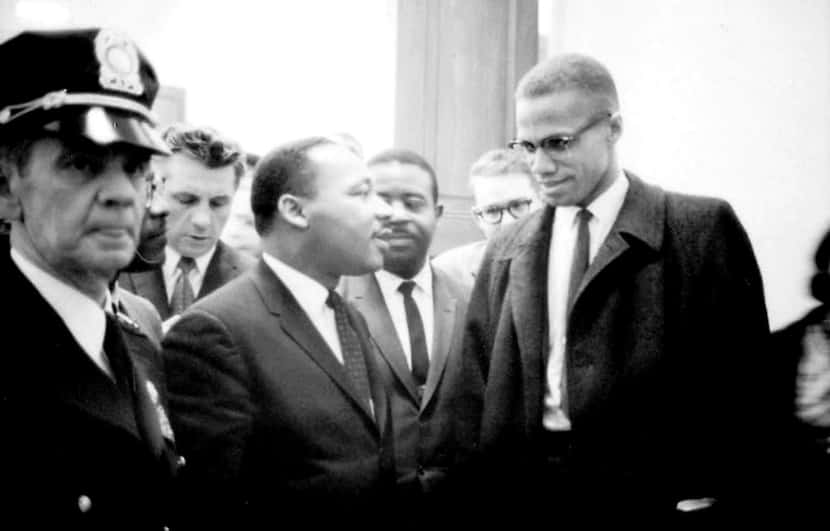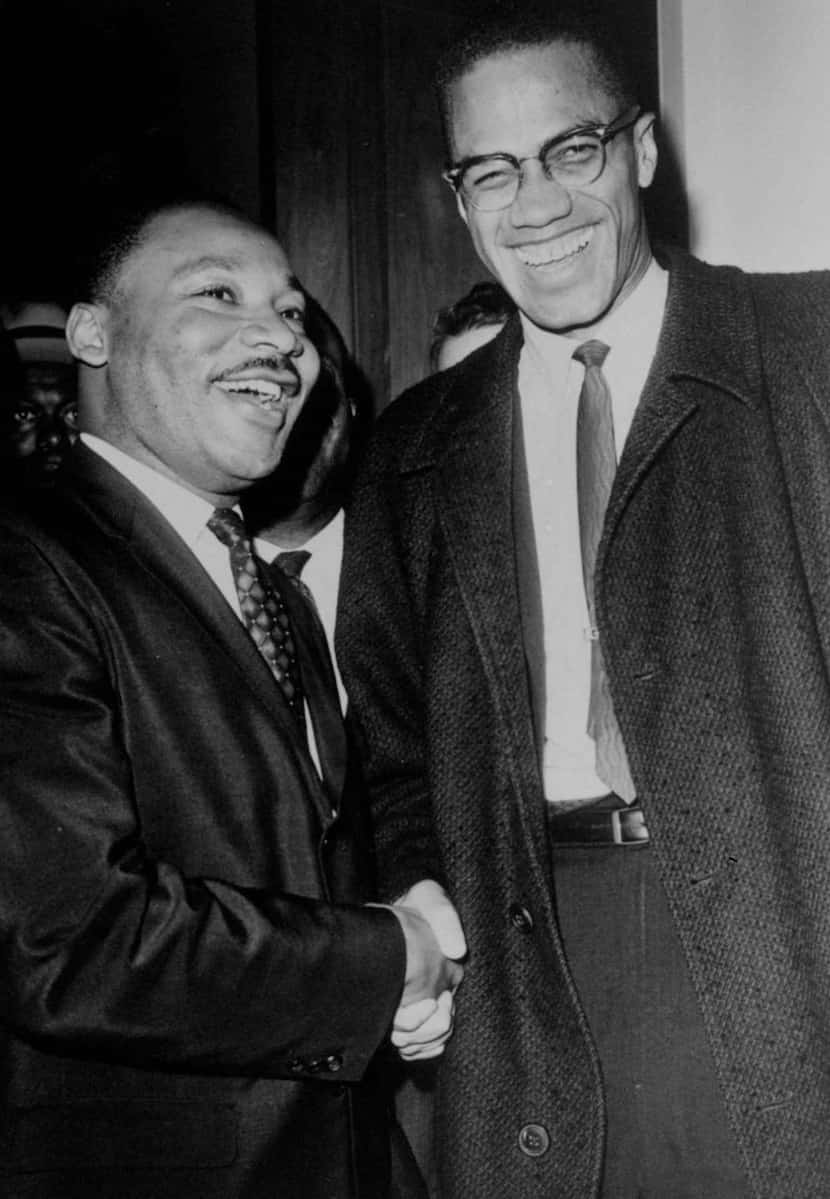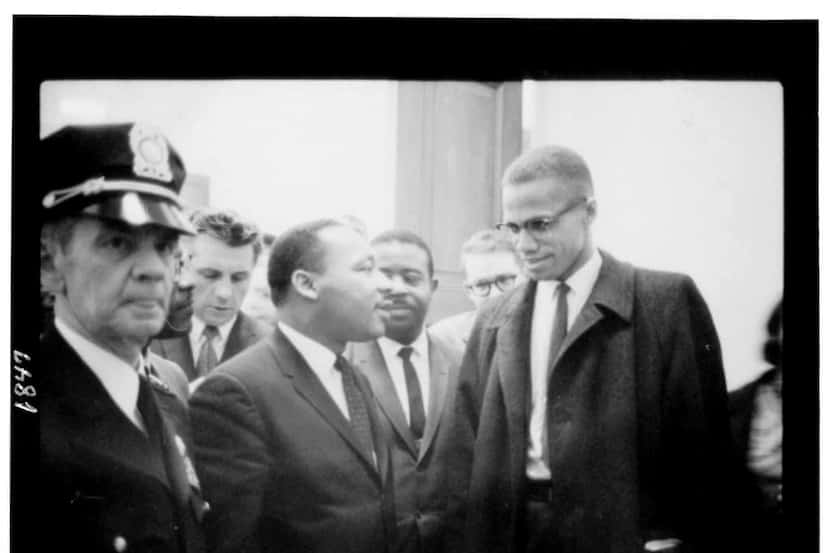Martin Luther King Jr. and Malcolm X met only once. On March 26, 1964, the two black leaders were on Capitol Hill, attending Senate debate on the Civil Rights Act of 1964.
King was stepping out of a press conference, when Malcolm X, dressed in an elegant black overcoat and wearing his signature horn-rimmed glasses, greeted him.
"Well, Malcolm, good to see you," King said.
"Good to see you," Malcolm X replied.
Cameras clicked as the two men walked down the Senate hall together.
"I'm throwing myself into the heart of the civil rights struggle," Malcolm X told King.

King would say later: "He is very articulate, but I totally disagree with many of his political and philosophical views — at least insofar as I understand where he now stands."
The exchange would last only a minute, but the photo remains a haunting reminder of what was lost. They would never meet again before each was assassinated, first Malcolm X and then King.
That moment on Capitol Hill would continue to be analyzed by scholars for its import and its potential. Every word would be scrutinized. Some would call it the moment the two leaders reconciled. Others would say they were never that far apart. They both had the same goal: equal rights and justice for black people in America.
King and Malcolm X were often seen as adversaries in the black freedom struggle. Malcolm X, who advocated a nationalist approach to equal rights for black people, often taunted King, criticizing him for subjugating blacks to their white oppressors and teaching them to be "defenseless in the face of one of the most cruel beast that has ever taken a people into captivity."
In one interview, Malcolm X dismissed King as "a 20th-century or modern Uncle Tom."
King ignored the criticism. "We still advocate non-violence, passive resistance, and are still determined to use the weapon of love," King said during a March 22, 1956, news conference in Montgomery. "We are still insisting emphatically that violence is self-defeating, that he who lives by the sword dies by the sword."
Although the two men held what appeared to be diametrically opposing views on the struggle for equal rights, scholars say by the end of their lives their ideologies were evolving. King was becoming more militant in his views of economic justice for black people and more vocal in his criticism of the Vietnam War. Malcolm X, who had broken with the Nation of Islam, had dramatically changed his views on race during his 1964 pilgrimage to Mecca.
Eight months before their brief meeting on Capitol Hill, Malcolm X sent a letter to King, requesting a meeting. The letter was dated July 31, 1963. The return address was "MUHAMMAD'S MOSQUE NO. 7, 113 Lenox Avenue, New York 26, New York."
Malcolm X opened the letter with the greeting "Dear Sir." He called for a united front against racial oppression in the country.
"The present racial crisis in this country carries within it powerful destructive ingredients that may soon erupt into an uncontrollable explosion," Malcolm X wrote. "The seriousness of this situation demands that immediate steps must be taken to solve this crucial problem, by those who have genuine concern before the racial powder keg explodes. A United Front involving all Negro factions, elements and their leaders is absolutely necessary."
Malcolm X warned that a "racial explosion is more destructive than a nuclear explosion," citing a recent meeting between President John Kennedy and Soviet Premier Nikita Khrushchev.
"Despite their tremendous ideological differences," Malcolm X wrote, "it is a disgrace for Negro leaders not to be able to submerge our 'minor' differences in order to seek a common solution to a common problem posed by a Common Enemy."

Malcolm X invited King to a rally that August in Harlem to analyze the race problem and a solution. He promised to moderate the meeting and guarantee courtesy for each speaker. He requested that if King could not attend to send a representative, closing the letter with an endearment: "Your Brother, Malcolm X."
King declined the invitation and did not send a representative, according to the book, "Malcolm and the Cross: The Nation of Islam, Malcolm X, and Christianity," by Louis A. DeCaro.
The next month, on Aug. 28, 1963, King would lead more than 250,000 people in the March on Washington and deliver his now-famous "I Have a Dream" speech.
Malcolm X attended the march, but called it "the Farce on Washington."
"Yes, I was there," he wrote. "I observed that circus. Who ever heard of angry revolutionists all harmonizing 'We Shall Overcome ... Suum Day ...' while tripping and swaying along arm-in-arm with the very people they were supposed to be angrily revolting against? Who ever heard of angry revolutionists swinging their bare feet together with their oppressor in lily-pad park pools, with gospels and guitars and 'I Have A Dream' speeches? And the black masses in America were — and still are — having a nightmare."
The Nov. 22, 1963, assassination of Kennedy led to a push for the Civil Rights Act, a major piece of legislation that Kennedy had supported.
In Washington, as King presided over a news conference, Malcolm X sat quietly in the back of the conference room.
When the news conference ended, King left through one door and Malcolm X exited another. Malcolm X stopped King in his path. The two shook hands.
The following year, Malcolm X went to Selma, Ala., where he had a cordial meeting with Coretta Scott King and other civil rights leaders. King was in jail at the time but recalled later:
"He spoke at length to my wife, Coretta, about his personal struggles and expressed an interest in working more closely with the nonviolent movement. He thought he could help me more by attacking me than praising me. He thought it would make it easier for me in the long run. He said, 'If the white people realize what the alternative is, perhaps they will be more willing to hear Dr. King.'"
Only a few days after his visit to Selma, on Feb. 14, 1965, someone firebombed Malcolm X's house in New York, while he and his family slept inside. A week later, on Feb. 21, 1965, Malcolm X was assassinated by Black Muslim extremists during a rally in New York City's Audubon Ballroom.
In his Amsterdam News Column, King mourned him. "Like the murder of (Congo Prime Minister Patrice) Lumumba, the murder of Malcolm X deprives the world of a potentially great leader. I could not agree with either of these men, but I could see in them a capacity for leadership which I could respect.''
In a telegram to Malcolm X's widow, Betty Shabazz, King wrote: "While we did not always see eye to eye on methods to solve the race problem, I always had a deep affection for Malcolm and felt that he had a great ability to put his finger on the existence and root of the problem."
Three years later, on April 4, 1968, Martin Luther King was assassinated in Memphis. He was the same age as Malcolm X: 39.
DeNeen L. Brown, The Washington Post


/cloudfront-us-east-1.images.arcpublishing.com/dmn/FTXZRZB3AJNRHINQ4K42QB3NJE.jpg)
/cloudfront-us-east-1.images.arcpublishing.com/dmn/TXWPK6QJXZAUF5LPZKLSHMO42U.jpg)
/cloudfront-us-east-1.images.arcpublishing.com/dmn/QHNQ4MYH6RFKFMOEVCOTE4W6DE.jpg)
/cloudfront-us-east-1.images.arcpublishing.com/dmn/XDI4432JBFDRNAW33PARNWMWNA.jpg)
/cloudfront-us-east-1.images.arcpublishing.com/dmn/FE2VEAW4KFGXFF3VAGVH3RJOYY.jpg)